Louisa Serene Richardson's Ancestors |
Click on a name for info, click on an arrow to follow that branch, click Home to go to the main page, or click for an Alphabetic List of all Names. |
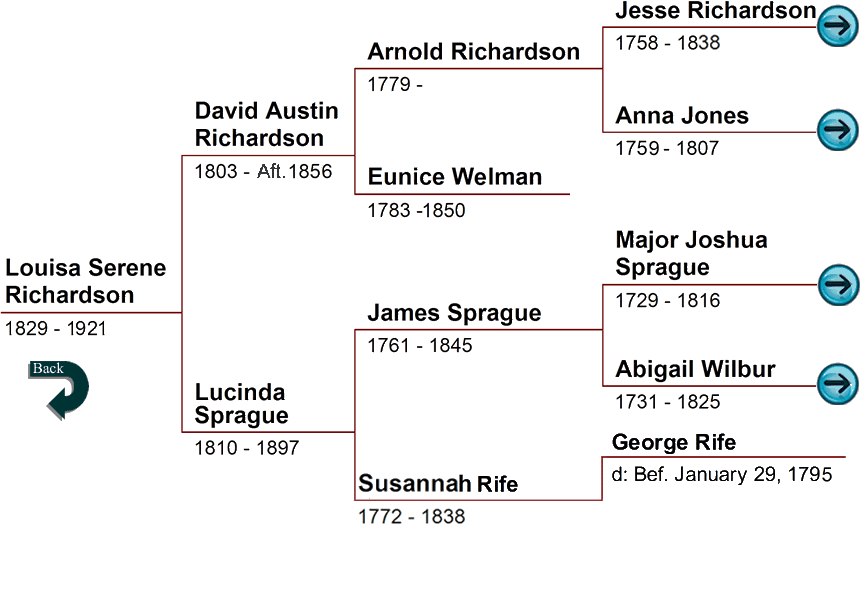 |
David Austin Richardson was born October 1, 1803, in what was then Black Rock, Genesee County, New York to Arnold Richardson and Eunice Welman. On that same census, living nearby is Samuel Sprague, born in PA, Lucinda's brother, with wife Nancy and six children. Shortly after this, David went to Vigo County, Indiana where two of his brothers-in-law, James and Ralph Sprague, resided. The other members of his family followed by wagon to the new home in 1851. The 1860 census shows Lucinda living in Indiana without David. One record says David Austin Richardson died in 1850 in Terre Haute, Indiana. According to Sprague Families in America, by Dr. Warren Vincent Sprague, he was in Hancock County, IL, in 1856, intending to go to California (this was the time of the California Gold Rush). He was not heard from after this. Mouse over map left to view the Township map of Muskingum County. It is interesting to note that on June 23, 1858, a David A. Richardson married Lavina Weston in Hancock County, Illinois. To make it even more interesting, there is an 1860 US Census for a 56 year-old David A. Richardson, a blacksmith who was born in New York, living with a 25 year-old Lavina Smith and a one year-old boy named Marion Richardson. This was in a town called Rough and Ready, which is in Harmony Township, Hancock County, Illinois. Unfortunately, the 1860 census does not state the relationships between these three. But it seems very likely that this is our David. Further research did not produce any other information on these three people. |
| ~< Back to Chart >~ |
Lucinda Sprague was born on February 19, 1810, in Wakatonica, Washington County, Ohio. She was the sixth of eleven children born to Revolutionary War veteran James Sprague and his second wife, Susannah Rife. When Lucinda was 17 years old, she married David Austin Richardson on May 10, 1827, in Muskingum County, Ohio. They had ten children all born in Ohio – ancestor Louisa Serene (see her info); Andrew J. born on October 8, 1831, who marched with Sherman to the sea near the end of the Civil War; William Edward born on July 28, 1833, died on his 6th birthday in 1839 in Ohio; Almiran G, called James, was born on September 16, 1835, and also fought in the Civil War; Mary Ann born on December 7, 1838; William Edward (2nd of this name) was born on October 2, 1840 and was taken prisoner in the Civil War, released in a prisoner exchange and fought under Sherman in Atlanta; Eunice born on December 17, 1842; Lucinda on February 24, 1845; Martha Jane born on March 2, 1847; and Clark L. born on July 30, 1849. Sometime after November 2, 1850, David left for Vigo County, Indiana. Lucinda and the children followed him there in 1851. By the time of the US census dated June 9, 1860, Lucinda's husband David was gone. It shows Lucinda, age 50, living in Prairie Creek Township, Vigo County, Indian, with her children – William 20, a farm laborer; Eunice 17, a domestic; Martha 13; and Clark 10. The 1870 census dated June 23, 1870, records Lucinda as living with her son Clark and his family in Shelburn, Curry Township, Sullivan County, IN. On June 25, 1887, she is listed as a witness to her granddaughter Harriet Stanley’s marriage in Shelburn. In the Sullivan Democrat newspaper for Tuesday, December 13, 1887, under the Local Correspondence section for Johnson Station it states that “There is some sickness here at present; Grandma Richardson is very sick with erysipelas.” (Erysipelas is a bacterial infection in the upper layer of the skin.) Johnson Station can not be found on a map today, but there is a Johnson, Indiana, 85½ miles east of Shelburn, which may be where she was living. Lucinda Sprague Richardson died in Shelburn on July 29, 1897 at age 87 and is buried in the old section of the Little Flock Cemetery, located on the south end of Shelburn. The inscription reads “Lucinda Sprague Wife of D.A. Richardson Died July 29, 1897 Aged 87 yrs.” On the bottom of the stone there is a two-line inscription that is barely readable. What can be read says “. . . Mother rest in quiet sleep . . . sorrow . . .” The announcement of her death was printed in two different newspapers. The first was in the Farmersburg Progress on Thursday, August 5, 1897. It read “Rev Couchman was called to preach the funeral of Grandma Richardson, who departed this life Wednesday night. The bereaved family have our heartfelt sympathy.” The second was printed on August 6, 1897, Friday, in The Sullivan Democrat and reads as follows: “-Shelburn- Grandma Richardson, of this place, died Wednesday and was interred at the Little Flock cemetery Friday. The bereaved family and friends have our sincere sympathy.” It seems she was well respected and much loved. |
| ~<^>~ |
Arnold Richardson was born September 25, 1779, in Somers, Tolland County, Connecticut. He was the first of at least five children born to Jesse Richardson and Anna Jones. When Arnold was 20 he married Eunice Welman on March 27, 1800, in Longmeadow, Hampden County, Massachusetts, which is about 10 miles northwest of Somers. That same year they are listed in the census for Somers, Connecticut. In 1803 they had a son, David Austin, in Black Rock, Genesee County, New York, which is part of modern day Buffalo. The 1810 US census shows an Arnold Richardson in Hartford Township, Luzerne County, Pennsylvania. Arnold is the right age. Eunice and David would also fit along with two other boys under 10 and two daughters under 10. This would also fit with the 1850 census, which shows Arnold living with Ann Kellogg, possibly his married daughter, who was born in Pennsylvania about 1815. There is an Arnold Richardson in the 1820 US census, that could be him, living in Scipio, Cayuga County, New York, about 110 miles east of Black Rock. This Arnold had seven children – three boys under 10, one 10 to under 16, one 16 to under 18, (this could be ancestor David Austin) one girl under 10, one 10 to under 16, and one 26 to under 45, which would be wife Eunice. This Arnold is “engaged in Manufactures.” It is not known when or where Arnold died, but there is an Arnold Richardson aged 70 living in Lockport, Niagara, New York, USA in the 1850 US Census dated July 16. Being that his son David Austin was born about 20 miles from here, and a Eunice Richarson died there that same year, this may be him. |
| ~<^>~ |
|
| ~< Back to Chart >~ |
James Sprague was born in 1761 in Smithfield, Providence County, Rhode Island. He was the fifth of thirteen children born to Joshua Sprague and Abigail Wilbur. The next year, his family moved to Sackville in Nova Scotia. (See Major Joshua Sprague for details.) About 14 years later, the Spragues and many others were forced to leave because of their pro-colonist stance. The family returned to Rhode Island and then moved to Massachusetts. James was fifteen years old when he enlisted as a Private on November 1, 1776, serving three years in Captain Eli Leavenworth’s Company, Colonel Meigs Regiment of the Connecticut Line. It was at this time that he married Mary Spooner of Harwick, Worcester County, Massachusetts, probably in Connecticut. Their first child, Lydia, was born in Warren, Litchfield County, Connecticut on September 28, 1777. During the war, they moved to Adams, Berkshire County, Massachusetts, where James’s parents and younger siblings lived. Four more children were born there - Anson on October 3, 1781; Ralph who was born about 1784; and Phebe and a twin who were born on February 23, 1788, but the twin died a few days after its birth.
James’ name appears a few times in the court records of Adam Miller, Esq., Justice of the Peace of Brothers Valley Township. The first two state that in the fall of 1793 James was in debt. The first was simply dated September 1793 and reads “note of debt.” The second one was dated October 31, 1793 and states he was in debt to Henry Greenewalt, which supports the idea that Henry was James’ landlord. The third seems to be a physical fight between Daniel, John and Susana Fluck with James that reads in part, “Daniel Fluck . . . Shall keep the peace be of good behavior and especially toward James Sprague, Constable of said county. . . . Condition for the appearance of Susana Fluck at the Court of Quarter Sessions of the Peace to be held at Bedford the 28th day of April 1794 to answer unto a Endictment for assault and battery committed on the body of James Sprague . . .” Note that James is now County Constable. On January 25, 1795, James married Susannah Rife in Bedford County, and remained in the Greenewalt house in Brothers Valley. James was the administrator of her father’s estate and applied for a land warrant on May 8, 1795, for Susannah's portion of her father's estate. 1795 is the year that the Brothers Valley Township became part of a new county called Somerset. Not only were county lines changing, but township boundaries also. By January of 1796, James was taxed for 230 acres of land, 20 of which were cleared, a house, a horse and two cattle in Bedford Township in Bedford County. Lydia, James eldest daughter by his first wife Mary, married George Bainter in this year in Bedford County. Lydia with her brother Anson, sister Phebe, her husband George and his family continued the journey to Ohio. James and Susannah remained in Pennsylvania, probably to settle the Rife estate, where they had two children. James is again mentioned in the court records, this time in the 1796 December Term of the Civil Court Docket of Somerset County. It reads, “Pleas enrolled at Somerset the third Monday (the 19th) of September 1796, before John Wells, Esq., and his associate judges. . . . Martin, Peter, vs. James Sprague. Appeal from judgment of Adam Miller by the defendant.” Unfortunately nothing more is known about this. The 1797 and '98 tax records has him taxed in Bedford Township again, but the 1798 detailed tax sheet records only the 100 acre Warranted Land with 10 acres cleared and 3 Horses-Cattle and results in a 75 cent tax. On the October 1, 1798 U.S. Direct Tax Lists James and family are living in an 18' by 18’ cabin on 233 acres owned by the Heirs of George Rife (mouse over image to read survey text). On October 10, 1799, James and Susannah sold the two parcels of land that she inherited to George Ice for £100 each. One was for 126 acres and the other for 128 ¾ acres, both on the Glade Road. In 1804, James was defendant in a suit of slander against Samuel Courier. The charge was that James used the words “You are a thief, and I can prove it” and the requested damages were $500. Although James lost the suit, the damages awarded were only $3. This was the first verdict rendered in Muskingum County. James then hired Courier’s lawyer and sued Courier for a $100 debt. Unfortunately, James lost this suit and had to pay the costs. On the first Monday in April of 1805, James was elected as one of two “Overseers of the Poor.” In Wakotomica, he ran a gristmill for another party. The Indians from a village that is now Otsego came over with small packages of grain to grind. Being a lover of hunting, he visited the village and liked the locality. He soon moved his effects there on a sled. In 1812, James, with sons Samuel, Jonathan, and Elijah, cut a road from Symmes Creek to White Eyes Creek and to the Indian Village, which lies on the west side of Wills Creek Lake. They moved there that year, being the first white settlers and bringing the first wagon that was ever in Monroe Township. His first house was built on the northwest corner of Section Thirteen, raised by himself and his family. On January 7, 1804, the Ohio government authorized the creation of Muskingum County. The county’s name came from an Indian word for “near the river.” James Sprague applied for a war pension on May 25, 1818, from Muskingum County at age 58. According to a court deposition on April 24, 1824, he gave his wife Susanna's age as 52 and children living at home -William age 19; Elias 18; Lucinda 16; Rosanna 12; Lavina 8; James 6; and Ralph age 4. James is a farmer, but unable to work ¾ of the time due to illness. His schedule of property states he owns one small mare worth $30; a colt, $40; nine head of cattle, $70; fourteen head of sheep and five lambs, $23.50; debts due to him are $16; and he owes $60 in debts.
James Sprague was described as a tall, strong, large boned man, 185 to 200 pounds, a fine example of the Ohio hunter and pioneer. He dressed in buckskins, wearing a fringed hunting shirt and coonskin cap. James was known as a great wolf hunter. Trading in wolf scalps was one of the few ways to make money, so many a wolf fell to his accurate aim. This hardy Revolutionary War Veteran, pioneer and hunter, passed his life without severe sickness, and died in Monroe Township on July 29, 1845, seven years after his wife Susanna, at the great age of nearly ninety-seven years. His estate was entered as case number 2358, at the September Term 1845 court session (mouse over image above). Martin Richardson was appointed Administrator of his estate, which seems to indicate he died without a will. James’ sons, Samuel and Elijah Sprague, are mentioned as securities in the docket paperwork. A legal notice was published in the newspapers beginning on November 1, 1845, and running through the month. According to Lorle Porter, Ph.D, in her book A People Set Apart: Scotch-Irish in Eastern Ohio: from the Forks of the Yough to the Killing Fields of Georgia, James Sprague is buried in the Otsego Memorial Cemetery pictured below in his wife's bio. In her book, his name appears on a list recorded by The W.P.A. Graves Project of Revolutionary War Veterans buried in the Otsego Cemetery. This cemetery was once called the Pleasant Valley Methodist Church Cemetery that James and Susannah Sprague helped to form. |
| ~< Back to Chart >~ |
Susannah Rife was born about 1772 in Pennsylvania, the oldest of five children born to the wife of George Rife whose name is unknown. This ancestry is based on land and tax records for Bedford County, Pennsylvania. Her father died in the latter part of 1794 and Susannah inherited a quarter of his estate. On January 25, 1795, when Susannah was about 23, Justice of the Peace Adam Miller married her to James Sprague in Brothers Valley Township, Bedford County. Four days later on the 29th, James is made Administrator to her father’s estate. A few months later on May 8th, James was listed as the Administrator of George Rife’s estate and was deeded 100 acres and the dwelling, which was only listed as an Improvement. In 1798 the U.S. Direct Tax Lists for Pennsylvania, contained three records for a James Sprage, as living in a dwelling owned by the “Heirs of Geo. Rife.” The record described as “Bedford County 1st Assesment District, 8th Division” is dated October 1st and has the dwelling listed as an 18 x 18 Cabbin being worth $15, on 233 acres of land in Bedford County. On October 10, 1799, when James and Susannah sold the two parcels of land that she inherited, Susannah was “first examined separate and apart from her said husband” by the Justice of the Peace, to make sure she was fully aware and willing to sell her land. The family then went to Ohio. James and Susannah had eleven children, the first two born in Pennsylvania and the rest in Ohio –Samuel, born March 4, 1796; Jonathan, born February 20, 1799; Elijah, born July 23, 1801; Elizabeth, called Betsey born about 1803; William born about 1805; Elias, born December 18, 1807; ancestor Lucinda; Rosana, born July 2, 1812; ancestor Lavina, Susannah Rife Sprague died in 1838 probably in Otsego, Monroe Townsip, Muskingum County, Ohio and is thought to have been buried in the Pleasant Valley Methodist Church cemetery. That church was torn down in 1870, and a "neat and comfortable house", 28 x 50, was built in its place. Sometime after 1882, the house was taken down and a new church was built. While that original church has long since disappeared, the cemetery remains in that location now called the Otsego Memorial Cemetery, surrounding the newer Otsego United Methodist Church. The older gravestones are on the east side of the most recent church. Unfortunately a stone cannot be found for her. Some researchers believe she died in Knox County, Indiana, while visiting her son William. It is not known for certain where she died or is buried. |
| ~< Back to Chart >~ |
Jesse Richardson was born on February 3, 1758, in Coventry, Tolland County, Connecticut, to David Richardson and David's second cousin Rachel Richardson. When he was about 8 years old, his family moved from Coventry to Somers, Tolland County, Connecticut. Jesse was not yet 17 when the Revolutionary War began, and he enlisted on July 7, 1775, with his brother David. Jesse served until December 16th in Captain Pease’s 3rd Company in Colonel Hunton’s Connecticut Regiment. The Pease family were prominent members of Somers. In 1776, with his brother Sanford, Jesse enlisted again with Captain Pease in Colonel Erastus Wolcott’s Connecticut Regiment and served nine months, being discharged on January 1, 1777. He enlisted again in 1778 and served one year in Captain Haws’ Company in Colonel Mason’s Connecticut Regiment. At the end of that last tour of duty, when he was 20, he married 19 year-old Anna Jones on November 12, 1778 in Somers, at the Congregational Church. Jesse and Anna had at least eight children, see Anna for details. When the war ended, Jesse and his brother Sanford purchased adjoining lots in Royalton, Windsor County, Vermont. Jesse traveled between Connecticut and Vermont often. He sold land that he lived on in Springfield, Windsor County, Vermont on May 6, 1782. It is not clear if his wife was with him during this time, but he must have returned to Somers by 1785, as his twins were born there. By the 1790 census Jesse, Anna and their family of three sons and two daughters were in Royalton, living on the land next to his brother Sanford and near another Richardson family headed by a man named Godfrey. Springfield is 111 miles north of Somers; Royalton is 51.6 miles north of Springfield. So it was possible to go back to Somers frequently. Sometime before the 1800 U.S. census was taken, probably in 1795, Jesse and family returned to Somers and settled there for the next 20 or so years. This census has them living in Somers with six children, three boys and three girls and one other Free Person. In 1807, Jesse’s wife died leaving him with a 14 year-old son and three daughters still at home. Six month’s later Jesse married Lydia Rowley on March 24, 1808 in Somers. Lydia gave birth to a stillborn infant on February 18, 1809, and then daughters – Philancy Ann, born on April 5, 1810 and baptized on June 24th in Somers; Leonora, who was also baptized in Somers on December 18, 1814; and Sophronia, born about 1818 probably in Ohio. On the 1810 census (taken for August 6, 1810) Jesse and Lydia were still in Somers with four children, a boy and two daughters from his first marriage and newly born daughter Philancy. A little bit about these three daughters: Philancy married Dr. Nathan H Cass on January 8, 1829, in Muskingum County, Ohio, then divorced him, and married Riley Gray on September 10, 1863 in Charlestown in Monroe Township, Clark County, Indiana, where she died, but is buried with her first husband in the Mountain Grove Cemetery; Leonora, married Martin Larntz in Muskingum County, Ohio, died there and is buried in the Otsego Memorial Cemetery; and Sophronia married Robert Waters on April 28, 1835, in Muskingum County, Ohio, died there and was buried in the United Methodist Churchyard Cemetery in Otsego. Church records tell us that on May 4, 1817, Lydia was dism. [dismissed] to any Cong. [Congregational] or Presb. [Presbyterian] church in Ohio. This is shortly before they left with others, including his brother David for Monroe Township, Muskingum County in Ohio where David became a prominent member and founder of the town of Otsego. Jesse wrote his will (click on image left to enlarge in a new window/tab) in Ohio on September 5, 1830, and mentions his four daughters by name and names wife Lydia as executrix and his son Rufus as executor. He applied for his War Pension in 1833 from Ohio and was granted $80 per year retroactive to 1831. It is not known where Jesse is buried, but it may be in the Richardson Cemetery in Otsego (mouse over image right) where his brother David and other Richardson family members are buried. On November 4, 1850, the date of the census, Jesse’s widow Lydia was living with her daughter Leonora in Monroe Township. |
| ~<^>~ |
Anna Jones was born on September 28, 1759, in Somers, Tolland County, Connecticut. She was the seventh of eight children of Zebulon Jones and Anna Kibbe. When Anna was just over 19 years old, she married 20 year-old Jesse Richardson, on November 12, 1778, in Somers, at the Congregational Church. They had at least eight children, most born in Somers – ancestor Arnold; an unnamed daughter born between 1780-1784, was recorded on both the 1790 and 1800 census, who probably died young; Jesse on June 3, 1781, who probably died before 1785; twins born on on February 3, 1785-Joseph, who was one of the earliest pioneers and occupants of Fort Harrison in Vigo County, Indiana, and Jesse, who married Sarah, was a farmer in Hancock, Illinois, and died there at the end of 1850 or early 1851; another unnamed daughter born between 1786 and 1790, who apparently died young; Rufus on December 24, 1793, who was born in Royalton, Windsor County, Vermont, served in the Second Connecticut State Troops Military Regiment, married Mary Rowley Watrous in Muskingum County, Ohio and then married Jemima Gettings there, but died in Terre Haute, Henderson County, Illinois and is buried in the La Harpe Cemetery; and Weltha born October 26, 1802, in Somers, married James Lull in Muskingum County, Ohio, and died in Crawford County, Illinois and is buried in the Old Robinson Cemetery. Anna Jones Richardson died on September 7, 1807, in Somers, 20 days before her 48th birthday, although the church records state she was 52. She probably is buried in the Somers Congregational Church graveyard. |
| ~< Back to Chart >~ |
Major Joshua Sprague was born on July 3, 1729, in Smithfield, Providence County, Rhode Island. He was the last of six children born to Captain William Sprague and Alice Ellis Brown. When Joshua was 19 years old, he married Amy Darling on January 2, 1748 at Cumberland, Rhode Island. Their marriage is recorded in volume three of James N. Arnold’s compilation of the Vital Records Of Rhode Island as “SPRAGUE Joshua, of Smithfield, and Amia Darling, of Cumberland; m. by , Job Bartlett, Justice. Feb. 7, 1748-9.” Amy was born in May of 1729 and died in May of 1749 giving birth to their daughter Amy at Smithfield, Rhode Island. The next year, when he was 20, Joshua married Abigail Wilbur 18 years old, on April 22, 1750 in Rhode Island. They had their first six children there (see Abigail Wilbur for details). On July 21, 1762 Joshua Sprague and wife Abigail, of Smithfield, sold the land “inherited from their honored father, William Sprague” for 1,200 pounds and moved his family to Sackville, in the granary of Nova Scotia, Canada. The government there had expelled the French Acadians from there because they refused to sign an oath of loyalty to the British in 1755, at the beginning of the Seven Years War with France. (Many of them moved to Louisiana, where they became the Cajuns.) The British, wanting to strengthen a British presence there, offered land to British colonists. Joshua Sprague, was a member of a committee appointed to admit persons into the township of Sackville, and by 1763, 65 families had settled there; years later the township had a population of three hundred and forty-nine people, all but six from New England. The Spragues had six more children while there (see Abigail below for details).
Warren Vincent Sprague, in his book Sprague Families in America, gives a detailed account of his life, which is repeated here in part: “Mr. Sprague was enthusiastic in the cause of freedom, as were his sons. He enlisted as private in Colonel Archibald Crary's Regiment in 1776; had due him 20 pounds, 12 shilling, 10 pence. In Massachusetts, he served as Major in Colonel Joab Stafford's (Independent) Company of volunteers and fought in the battle of Bennington, August 16, 1777. He marched to Fish Kill, June 6, 1778, to serve nine months in Colonel Diamond's Regiment, but was rejected as unfit for service. However, on October 17, 1779, he enlisted as private in Captain Asa Barnes's (1st) Company, Colonel Israel Chapens' 3d Regiment, and was discharged November 21, 1779, serving one month and nine days. After the war Joshua and his sons, William and Jonathan, worked at the carpenter trade, building boats.”
“He always regretted that he went from Rhode Island to Canada. He said that he had a peck of silver dollars when he moved to Nova Scotia. Mr. Sprague was of the hardy pioneer stock; in the military records his height is given as six feet and complexion light. He was a man of more than ordinary strength and energy, which enabled him to withstand the hardships and privations attending the settling of a new country. His descendants at the time of his death numbered one hundred and sixty-three” Major Joshua Sprague died on October 1, 1816, in Coal Run, Washington County, Ohio. He was buried in the Sprague Cemetery (mouse over grave images above) located across the river from Coal Run, Ohio in Adams Township, Washington County, Ohio. A Sons of the American Revolutionary Star was placed on his grave (mouse over image left). Some of the above information was taken from the “Sprague Project” web site. |
| ~<^>~ |
When Abigail was about 18 years old, she married widower Joshua Sprague, 20 years old, it is believed in Smithfield, in Rhode Island and raised his year old daughter as her own. They had their first five children there, although birth records cannot be found for them. The children, as recorded by other researchers, are – Elijah on February 2, 1751; Nancy on October 23, 1753; Meribah on December 17, 1754; William on January 3, 1756; and ancestor James (some researchers say that James had a twin). Abigail and Joshua had six more children in Sackville, Nova Scotia, Canada – Frederick on October 17, 1762; Amy Lina Luna on November 12, 1763; Jonathan on January 9, 1767; Nehemiah in 1770; and Samuel about 1774. Her last child, Wilbur, possibly named after her maiden name, was born in 1777 in East Hoosac (now Adams) in Berkshire County, Massachusetts. Warren Vincent Sprague, in his book Sprague Families in America, states that Abigail, “who was of the honorable Wilbur family of Rhode Island is described as being rather tall of straight build and having dark hair.” See Major Joshua Sprague above for detailed info on their life together. Abigail Wilbur Sprague died on December 6, 1825, in Coal Run, Washington County, Ohio and is buried in the Sprague Cemetery across the river from Coal Run, Ohio. |
| ~< Back to Chart >~ |
George Rife's ancestry and early life is unknown. His name is listed on the 1771 List of Tavern Owners in Bedford County that was copied by Helen S. Hill in 1932 as follows: “George Rife, where he dwells, on Great Road from Bedford to the Glades about 10 miles from Bedford.” This information was also published in other media. Newspaper articles were printed in the Bedford Gazette in 1973 and 1995 and in the Bedford Inquirer in 1995. In 1983 James B and Vaugh E Whisker published a small book called Tavern Keepers and Inn Keepers of Bedford County, Pennsylvania. The location of George’s tavern is stated as above but they add, “Long Ridge, now known as Dry Ridge.” (See map at the end of this bio.)
There are tax records for him in Turkeyfoot Township for 1774 and 1776, and a Pennsylvania Septennial Census for 1779. There are several tax records for 1780 and 1781, which are more detailed. One states he is in Quemahoning in Milford Township in Bedford County. Another one, which simply says Milford Township, states he has “300 acres, 4 horses and 4 cows.” Another, dated 1781, is a running balance of the Classes, lists him under Eighth Class with an amount of £1.0.0 next to his name. The 1783 tax record says he owned “300 Acres; 2 Horses; 4 Cattle; 4 sheep; Tax: 11.3” There are two 1789 tax record entries for him. Both have him owning 400 acres with warrant rights, two horses and eight cows. But the one marked as Refendents Names has a valuation of 156, while the second one, which could be a duplicate list or another tract of land, shows his valuation as 344. These multiple tax records seem to indicate that George may have owned land in different areas of Milford Township. Other tax records for 1782 thru 1789 are also in Milford Township.
On the 1790 U.S. census, which was supposed to have been taken on August 2nd, George Riffe is listed as over 16 years of age, having two males under 16 and four females in the family. It is known that one of the boys was John who was born just prior to this census; the daughters were ancestor Susanna, Elizabeth born about 1778 and Catherine, birth date unknown. The fourth female was probably his wife, but the other son is unknown and probably died prior to George’s death, as he is not mentioned in the September 8, 1838 deed discussed below. The last tax records found during his lifetime are the 1791 Bedford County Tax Rolls and the 1792 Bedford Township Tax Rolls. In 1792, George’s total valuation was 209, and he was accessed 2s 6d for County Taxes for owning 100 acres, three horses and four cows. The last we know of George is his purchase on September 23, 1794 of the adjoining Glade Road land of 128¾ acres from his neighbor Arthur McGaughey. (See the survey above under James Sprague.) It can be assumed he was in good health and was still building his future but something happened to him, as a deed can not be found for this transaction, but the transaction is mentioned in a later deed dated October 31, 1799, of the sale of this land by the Sprague's (see James Sprague’s bio). George Rife died between September 24, 1794, and January 29, 1795, without a will. This was during the time when George Washington came to Bedford to put down the Whiskey Rebellion. Being that George was a tavern owner, he may have been one of the casualties of that conflict. The official Bedford County Register of Wills record lists him as a Non Resident, does not have a death date, just the Filing Date which was January 29, 1795. On this date the Administration Bonds, Bedford County records tell us, “Letters of Administration issued to James Spraig on estate of George Rife, deceased.” Ancestor James Sprague married George’s daughter Susannah just a few days prior on January 25th. The 1795 Bedford County Tax Rolls taken on February 2nd list him as “Rife, George or the tennant” with a County Tax of 4.10. Three months later on May 8, 1795, “James Sprague Administrator of the Estate of George Rife deceased makes application to the Land Office of Pennsylvania for 100 Acres of Land including an Improvement made by George Rife on both sides of the Glade Road in Bedford Township in the County of Bedford - in trust for the Heirs of the said George Rife.” This deed continues to say that the improvements made on this land were begun in July of 1791, which was after the sale of the 400 acres sold in 1790 mentioned above. In a deed dated September 8, 1838, for the sale of this same land between two other parties, we confirm the names of the Rife children. It states that George’s surviving four children each received a quarter of George’s estate: “. . . the said Rife died intestate leaving four children (viz John Rife, Susannah Rife, Catherine Rife, and Elizabeth Rife). Each entitled to a fourth part of the said tract (interlia) . . .” These 126 acres were Susanna’s inheritance deeded to her husband James Sprague. This deed continues to detail the land transfers that were made, each parcel beginning with a Rife child and in the case of the females, their husbands names are given: “and James Sprague intermarried with Susannah . . . Jacob Bainter intermarried with Elizabeth Rife . . . Dennis McVicker intermarried with Catherine Rife . . . John Rife entitled to one fourth part of the said tract interlia . . .” No mention is made of their mother or another brother.
|
| ~< Back to Chart >~ |

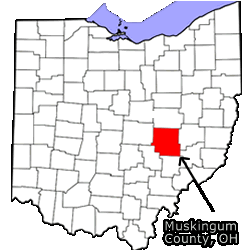 born in Ohio. This implies that the family visited New York prior to September 16, 1835, the date of Almiran's birth. See Lucinda Sprague below for more details on the children.
born in Ohio. This implies that the family visited New York prior to September 16, 1835, the date of Almiran's birth. See Lucinda Sprague below for more details on the children. 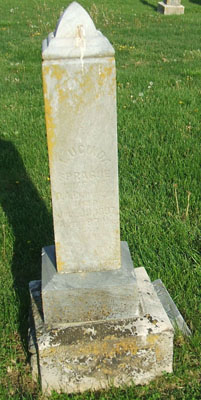
 Eunice Welman was born about 1783-4 to unknown parents. Some researchers believe she was born in in Genesee, New York, but it is more likely that she was born in Longmeadow, Hampden County, Massachusetts. When she was about 17 years old, she married Arnold Richardson in Longmeadow on March 27, 1800 and is listed as being from that town (see image) on the original record. They had at least one child, David Austin, born on October 1, 1803, in what was then Black Rock, Genesee County, New York. See her husband above for other possible children. It is not certain when or where Eunice Welman Richardson died, but there is a death record on the 1850 US Census Mortality Schedule which matches her age, place of birth (Mass) and residence at the time of death. It states that Eunice Richarson died at age 66 in May in the town of Lockport in Niagara County, New York. She had been sick for eight days with Black Landen.
Eunice Welman was born about 1783-4 to unknown parents. Some researchers believe she was born in in Genesee, New York, but it is more likely that she was born in Longmeadow, Hampden County, Massachusetts. When she was about 17 years old, she married Arnold Richardson in Longmeadow on March 27, 1800 and is listed as being from that town (see image) on the original record. They had at least one child, David Austin, born on October 1, 1803, in what was then Black Rock, Genesee County, New York. See her husband above for other possible children. It is not certain when or where Eunice Welman Richardson died, but there is a death record on the 1850 US Census Mortality Schedule which matches her age, place of birth (Mass) and residence at the time of death. It states that Eunice Richarson died at age 66 in May in the town of Lockport in Niagara County, New York. She had been sick for eight days with Black Landen.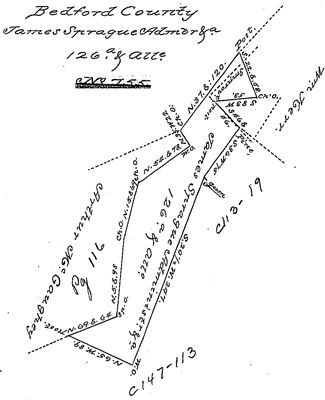 After the war, The U.S. Congress passed an act granting land in Ohio to the families that were driven from Nova Scotia and came to fight for the colonies. In about 1789, James and family left their home to settle in Ohio where James was granted 320 acres. Winter set in while crossing the Allegheny Mountains, and they stopped with their wagons until spring in Bedford County, Pennsylvania, to wait for spring's warmer weather before heading to Ohio. On the 1790 census for Bedford County, James Spreague is listed as being over 16 years old with 3 males under 16 and 2 females in the household. We know that there should be 2 boys and 3 females, so maybe the census taker got it wrong. The family lived in Brothers Valley Township, which is now in Somerset County. On the 1792 to 1795 Brothers Valley tax records, James is listed as “Sprague, James for Henry Greenewalt.” So it can be assumed that the Spragues rented a home from Mr. Greenewalt and paid the taxes on the farm. James’ wife, Mary became pregnant and gave birth to another child named Mary, who was born on February 28, 1792. Soon afterward, mother Mary became ill, so the family stayed in Pennsylvania. By 1794 James’ wife Mary and their son Ralph had died. James was left with four children, the eldest Lydia, was 17 years old and the youngest Mary was about 2 years old.
After the war, The U.S. Congress passed an act granting land in Ohio to the families that were driven from Nova Scotia and came to fight for the colonies. In about 1789, James and family left their home to settle in Ohio where James was granted 320 acres. Winter set in while crossing the Allegheny Mountains, and they stopped with their wagons until spring in Bedford County, Pennsylvania, to wait for spring's warmer weather before heading to Ohio. On the 1790 census for Bedford County, James Spreague is listed as being over 16 years old with 3 males under 16 and 2 females in the household. We know that there should be 2 boys and 3 females, so maybe the census taker got it wrong. The family lived in Brothers Valley Township, which is now in Somerset County. On the 1792 to 1795 Brothers Valley tax records, James is listed as “Sprague, James for Henry Greenewalt.” So it can be assumed that the Spragues rented a home from Mr. Greenewalt and paid the taxes on the farm. James’ wife, Mary became pregnant and gave birth to another child named Mary, who was born on February 28, 1792. Soon afterward, mother Mary became ill, so the family stayed in Pennsylvania. By 1794 James’ wife Mary and their son Ralph had died. James was left with four children, the eldest Lydia, was 17 years old and the youngest Mary was about 2 years old.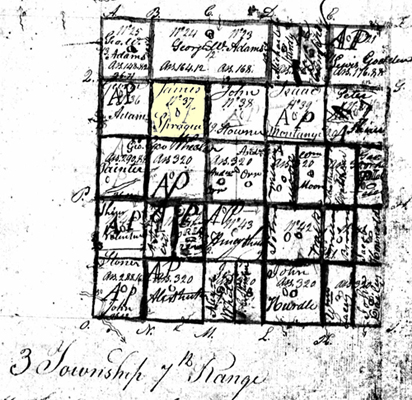 In January of 1800, James name is listed for the last time on the Bedford Township tax rolls, but his amount due is only 13 cents. Most likely, shortly after this, the Spragues continued the journey to Ohio and settled in Wakotomica, in what later became Muskingum County (mouse over image left). In Ohio, Susannah delivered an additional nine children. See
In January of 1800, James name is listed for the last time on the Bedford Township tax rolls, but his amount due is only 13 cents. Most likely, shortly after this, the Spragues continued the journey to Ohio and settled in Wakotomica, in what later became Muskingum County (mouse over image left). In Ohio, Susannah delivered an additional nine children. See 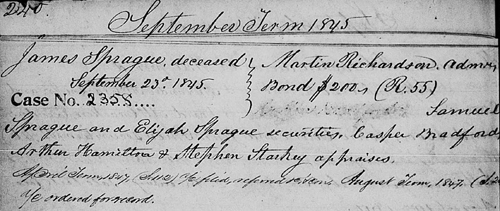 In 1828, James was the owner of the “Mary Ann,” one of the first steam powered boats on the Muskingum River. James and Susannah were founding members of the Pleasant Valley Methodist Protestant Church, which was organized in 1828-29. On February 10, 1831 James and Samuel Sprague purchased 80 acres of “unappropriated lands in the military District” from the US Government. On July 10, 1832, James sold a different piece of “unappropriated lands in the Military district, containing one hundred and fifty-four acres and four hundredths of an acre” to Jared Cone. His pension payment was transferred to Indiana on September 4, 1835. This is probably when they left Ohio, as in 1836 he and Susannah were living in Knox County, Indiana with son William R. Sprague. Susannah died in 1838 and in 1840 James was back in Muskingum living alone, but near several of his children.
In 1828, James was the owner of the “Mary Ann,” one of the first steam powered boats on the Muskingum River. James and Susannah were founding members of the Pleasant Valley Methodist Protestant Church, which was organized in 1828-29. On February 10, 1831 James and Samuel Sprague purchased 80 acres of “unappropriated lands in the military District” from the US Government. On July 10, 1832, James sold a different piece of “unappropriated lands in the Military district, containing one hundred and fifty-four acres and four hundredths of an acre” to Jared Cone. His pension payment was transferred to Indiana on September 4, 1835. This is probably when they left Ohio, as in 1836 he and Susannah were living in Knox County, Indiana with son William R. Sprague. Susannah died in 1838 and in 1840 James was back in Muskingum living alone, but near several of his children.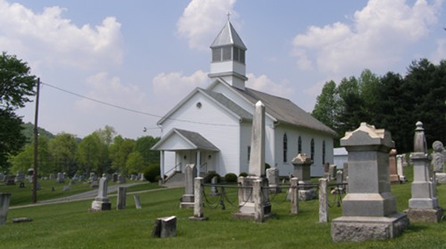 born July 29, 1814, noted as the first person born in the newly established township of Monroe; James, born March 6, 1817; and Ralph, born April 27, 1819.
born July 29, 1814, noted as the first person born in the newly established township of Monroe; James, born March 6, 1817; and Ralph, born April 27, 1819. 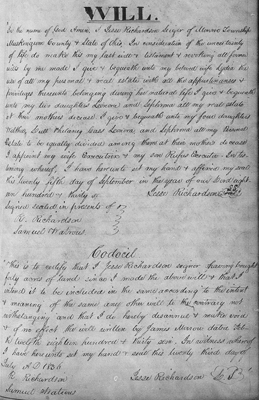
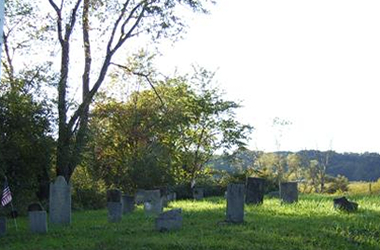 His son Rufus “declined & refused to act as such Executor . . . It is ordered by the court that Lydia Richardson be appointed Administrator. . .” Because of the codicil, the refusal of Rufus and the fact that the other witness, Samuel Watrous was now living in Illinois, the will was only partially proven and took a year to be fully proven. The inventory, which was done by Jesse’s brother David’s son Martin, wasn’t taken until June 1, 1839.
His son Rufus “declined & refused to act as such Executor . . . It is ordered by the court that Lydia Richardson be appointed Administrator. . .” Because of the codicil, the refusal of Rufus and the fact that the other witness, Samuel Watrous was now living in Illinois, the will was only partially proven and took a year to be fully proven. The inventory, which was done by Jesse’s brother David’s son Martin, wasn’t taken until June 1, 1839. 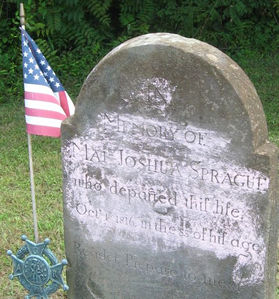 After farming there for about 14 years, local sentiments were turning against them and other settlers for their pro-colonies stance. In 1776, the Revolutionary War began and Joshua’s family came back to Smithfield after being expelled from Nova Scotia by the British government. They were forced to leave without any of their possessions. The Spragues went first to their old home at Smithfield, where Joshua’s father William still lived, and then in about 1777 to East Hoosac (now Adams) in Berkshire County, Massachusetts. They had their last child there – Wilbur in 1777.
After farming there for about 14 years, local sentiments were turning against them and other settlers for their pro-colonies stance. In 1776, the Revolutionary War began and Joshua’s family came back to Smithfield after being expelled from Nova Scotia by the British government. They were forced to leave without any of their possessions. The Spragues went first to their old home at Smithfield, where Joshua’s father William still lived, and then in about 1777 to East Hoosac (now Adams) in Berkshire County, Massachusetts. They had their last child there – Wilbur in 1777.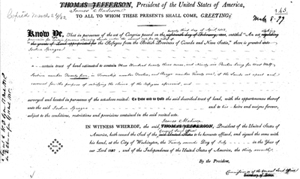
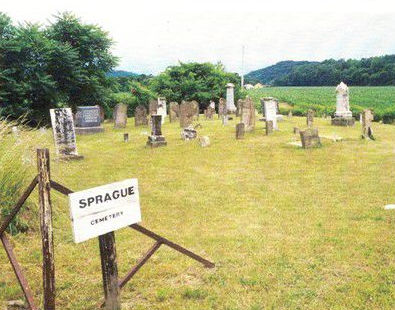 In 1788, “Joshua and his sons, William and Jonathan left Massachusetts, going to Simrell's Ferry, on the Monongahela river. They brought their tool chest on a two-wheeled cart drawn by one horse. Here they expected to remain and build boats, but after building several they were persuaded to come with the company that arrived at Marietta, June 22, 1788. Mr. Sprague and his two sons took a contract of building one of the block-houses and stockade called Fort Frye. Early in the spring, William and Jonathan had gone up to Waterford and cleared five acres of ground and planted corn, which produced a good crop. They lived in the stockade seven years, or until the Indian troubles were over. Joshua came into possession of a farm in Waterford Twp., on which he lived until 1812, when the infirmities of his years
In 1788, “Joshua and his sons, William and Jonathan left Massachusetts, going to Simrell's Ferry, on the Monongahela river. They brought their tool chest on a two-wheeled cart drawn by one horse. Here they expected to remain and build boats, but after building several they were persuaded to come with the company that arrived at Marietta, June 22, 1788. Mr. Sprague and his two sons took a contract of building one of the block-houses and stockade called Fort Frye. Early in the spring, William and Jonathan had gone up to Waterford and cleared five acres of ground and planted corn, which produced a good crop. They lived in the stockade seven years, or until the Indian troubles were over. Joshua came into possession of a farm in Waterford Twp., on which he lived until 1812, when the infirmities of his years 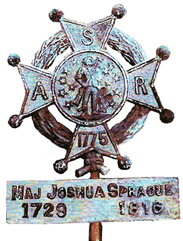 caused him with his wife to seek a home with their son Jonathan in Adams Township, where their remaining years were spent.”
caused him with his wife to seek a home with their son Jonathan in Adams Township, where their remaining years were spent.”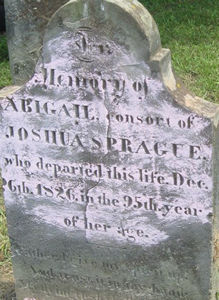 Abigail Wilbur is said to have been born on November 17, 1731, in Smithfield, Providence County, Rhode Island, the third child of eight, born to Daniel Wilbur and Sarah Fish. There is no official record found in the first six volumes of James N. Arnold’s compilation of the Vital Records Of Rhode Island for her birth. Her parentage is based on the data found in John Reid Wilbor’s and Benjamin Franklin Wilbour’s second edition of their book, The Wildbores In America. This book does contain some incorrect information, but it is respected as the best source for information on this family. The authors discuss the surname and state that it has been recorded in many different ways including Wilhar, Wilber, Wilbor, Wilbore, Willbur, Wilbour and Wilbur. They go on to say that “Generally speaking the William or Rhode Island branch use Wilbour and Wilbor, altho the other spellings also appear.”
Abigail Wilbur is said to have been born on November 17, 1731, in Smithfield, Providence County, Rhode Island, the third child of eight, born to Daniel Wilbur and Sarah Fish. There is no official record found in the first six volumes of James N. Arnold’s compilation of the Vital Records Of Rhode Island for her birth. Her parentage is based on the data found in John Reid Wilbor’s and Benjamin Franklin Wilbour’s second edition of their book, The Wildbores In America. This book does contain some incorrect information, but it is respected as the best source for information on this family. The authors discuss the surname and state that it has been recorded in many different ways including Wilhar, Wilber, Wilbor, Wilbore, Willbur, Wilbour and Wilbur. They go on to say that “Generally speaking the William or Rhode Island branch use Wilbour and Wilbor, altho the other spellings also appear.” 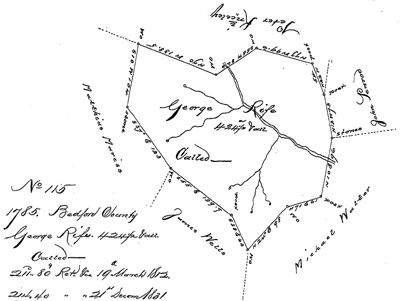 There are several land deeds filed for his name from several sources including the Pennsylvania, Land Warrants and Applications; The Calendar of Transactions, Bedford County, Deed Book A; Land Survey Abstracts, Book 1; Bedford County Archives, Volumes I and III; and the Deed Abstracts, Somerset County, Pa., Book 1. (Note Somerset County grew out of Bedford County shortly after George’s death, so records are in both counties. Turkeyfoot and Milford Townships were in Bedford, but today are in Somerset County.) There are also several tax and census records for his name in Bedford County. The records begin on September 3, 1773, when George purchased 150 acres of land with improvements in Turkeyfoot Township, Bedford County from Michael Hooff for one Pound and ten Shillings. On that same day another purchase was made from Hooff and Christian Engeny for 300 acres in Brothers Valley Township for eight pounds. In both of these cases, the deeds read that George was of the township where the land was being purchased. Both of these deeds were recorded years later, the first in 1803, after George’s death, and the last on May 5, 1783. This seems to indicate that the land deals were made before the written agreement was set down and certainly before they were recorded.
There are several land deeds filed for his name from several sources including the Pennsylvania, Land Warrants and Applications; The Calendar of Transactions, Bedford County, Deed Book A; Land Survey Abstracts, Book 1; Bedford County Archives, Volumes I and III; and the Deed Abstracts, Somerset County, Pa., Book 1. (Note Somerset County grew out of Bedford County shortly after George’s death, so records are in both counties. Turkeyfoot and Milford Townships were in Bedford, but today are in Somerset County.) There are also several tax and census records for his name in Bedford County. The records begin on September 3, 1773, when George purchased 150 acres of land with improvements in Turkeyfoot Township, Bedford County from Michael Hooff for one Pound and ten Shillings. On that same day another purchase was made from Hooff and Christian Engeny for 300 acres in Brothers Valley Township for eight pounds. In both of these cases, the deeds read that George was of the township where the land was being purchased. Both of these deeds were recorded years later, the first in 1803, after George’s death, and the last on May 5, 1783. This seems to indicate that the land deals were made before the written agreement was set down and certainly before they were recorded. 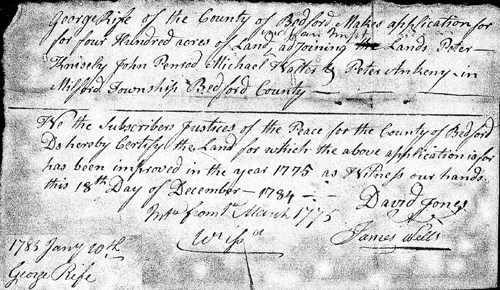 On January 10, 1785, “424 acres located on a branch of Coxes Creek, in Milford Twp, Bedford County,” were granted to George by warrant by the county officials because the land was “improved in the year 1775.” (Mouse over both the warrant application to the left and the image of the survey, directly above, for more info.) In 1786 and 1787, George’s name appears on lists of those who neglected to pay their taxes within the “forty days after Demand thereof hath been made . .” to the township of Milford. On March 13, 1790, prior to the census, George sold the quantity of four hundred acres of this land to Michael Tedrow for 360 pounds. On March 15, 1803, Mr. Tedrow writes in his will the “400 acre plantation on which he lives in Milford Twp., . . . bought from George Rife March 13, 1790.” It seems George sold the land that was warranted to him in 1785 and moved his family to another one of his properties that year.
On January 10, 1785, “424 acres located on a branch of Coxes Creek, in Milford Twp, Bedford County,” were granted to George by warrant by the county officials because the land was “improved in the year 1775.” (Mouse over both the warrant application to the left and the image of the survey, directly above, for more info.) In 1786 and 1787, George’s name appears on lists of those who neglected to pay their taxes within the “forty days after Demand thereof hath been made . .” to the township of Milford. On March 13, 1790, prior to the census, George sold the quantity of four hundred acres of this land to Michael Tedrow for 360 pounds. On March 15, 1803, Mr. Tedrow writes in his will the “400 acre plantation on which he lives in Milford Twp., . . . bought from George Rife March 13, 1790.” It seems George sold the land that was warranted to him in 1785 and moved his family to another one of his properties that year.  On the Pennsylvania, U.S. Direct Tax Lists, 1798, a George Keller is the Occupant listed for 1 Cab.n Stable and 30 acres situated on or near one Glade Road in Bedford Township belonging to the Heirs of George Rife. On that same page a Duncan McVicker is listed, who may be related to Dennis McVicker who married George’s daughter Catherine. It is not known who George Keller was, he could have been just a renter. That same year on April 23rd, the Orphan's Court Records of Bedford Co., PA states, “The Court appoint Valentine Werts as guardian over the person and estate of John Rife, a minor child of George Rife, dec'd, under 14 years of age, during his minority.” On December 16, 1799, another Bedford County Orphan Court record reads “. . . on motion of William Reynolds, the court appoint Valentine Wertz guardian over the person and estate of Catharine Rife, a minor under the age of twenty one years. She having come into Court and having chosen said Valentine Wertz.” Valentine Wertz was a neighbor of George Rife since March of 1793 when he was warranted “one hundred acres of Land on the dry ridge, & about one mile from the East end therefore, on both sides of the great road, in Bedford Township Bedford County.” (Mouse over Harison Township map above.) On December 24, 1805, “John Rife, minor child of George Rife, dec'd, being above the age of 14, came into court and chose Dennis McVicker as guardian over his person and estate during his minority.” This was John’s brother-in-law, married to his sister Catherine. By this time, his other sisters Susannah and Elizabeth already left for Ohio. Then in November of 1807 another record in the Orphan's Court reads “John Rife above the age of 14 years came into court and chose David McVicker guardian over his person and estate during his minority in R(?)oom of Dennis McVicker.” This is probably when Catherine and Dennis left for Ohio.
On the Pennsylvania, U.S. Direct Tax Lists, 1798, a George Keller is the Occupant listed for 1 Cab.n Stable and 30 acres situated on or near one Glade Road in Bedford Township belonging to the Heirs of George Rife. On that same page a Duncan McVicker is listed, who may be related to Dennis McVicker who married George’s daughter Catherine. It is not known who George Keller was, he could have been just a renter. That same year on April 23rd, the Orphan's Court Records of Bedford Co., PA states, “The Court appoint Valentine Werts as guardian over the person and estate of John Rife, a minor child of George Rife, dec'd, under 14 years of age, during his minority.” On December 16, 1799, another Bedford County Orphan Court record reads “. . . on motion of William Reynolds, the court appoint Valentine Wertz guardian over the person and estate of Catharine Rife, a minor under the age of twenty one years. She having come into Court and having chosen said Valentine Wertz.” Valentine Wertz was a neighbor of George Rife since March of 1793 when he was warranted “one hundred acres of Land on the dry ridge, & about one mile from the East end therefore, on both sides of the great road, in Bedford Township Bedford County.” (Mouse over Harison Township map above.) On December 24, 1805, “John Rife, minor child of George Rife, dec'd, being above the age of 14, came into court and chose Dennis McVicker as guardian over his person and estate during his minority.” This was John’s brother-in-law, married to his sister Catherine. By this time, his other sisters Susannah and Elizabeth already left for Ohio. Then in November of 1807 another record in the Orphan's Court reads “John Rife above the age of 14 years came into court and chose David McVicker guardian over his person and estate during his minority in R(?)oom of Dennis McVicker.” This is probably when Catherine and Dennis left for Ohio.